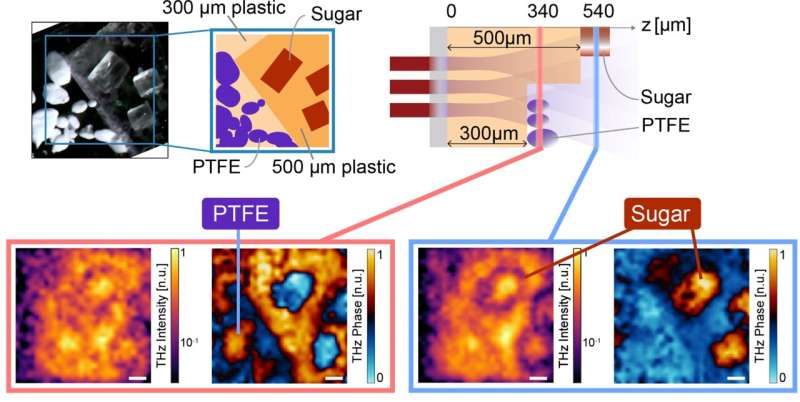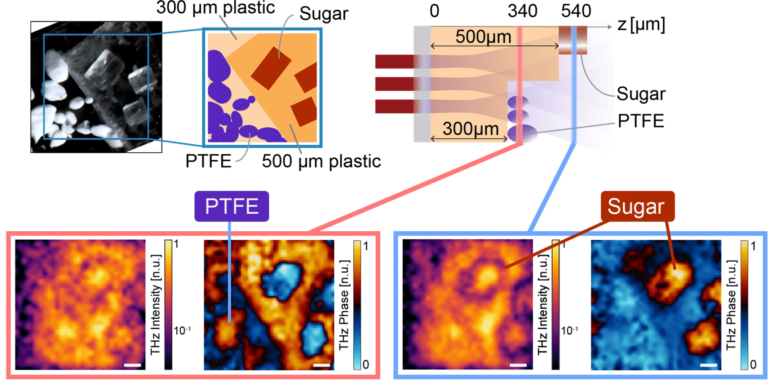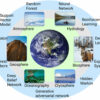Loughborough University scientists are the first to demonstrate that a terahertz wave camera can capture 3D images of microscopic items hidden inside small objects.
Lead researcher Dr. Luana Olivieri says though the research is in the early stages, the team’s latest study could have “major implications for a range of fields with relevance in cancer screenings, security, and materials research.”
The research, which is in collaboration with Professor Marco Peccianti, Dr. Luke Peters, Dr. Juan S. Totero and a team of experts from the Emergent Photonics Research Center (EPicX), demonstrates that terahertz waves can be used to locate and recognize embedded objects and features, such as cracks and bubbles, in microscopic three-dimensional space. The study has been published in the journal ACS Photonics and is featured on the front cover of the latest issue, published today (June 21).
Terahertz waves are a vastly unexplored part of the electromagnetic spectrum with frequencies ranging between microwave and infrared light. They have several properties that make them extremely useful, such as their ability to penetrate opaque objects without causing harm.
However, one of the main problems in the field of terahertz imaging is the limited ability to view microscopic objects.
Dr. Olivieri and the EPicX team have overcome this limitation by developing a unique approach known as “time-resolved nonlinear ghost imaging,” which combines a range of advanced detection methods and involves manipulating light and measuring how it travels through an object over time.
Their method allows smaller objects to be seen more clearly, though, until now, it was only proven to work on 2D objects.
In their latest study, the researchers proved the technique can capture 3D images of microscopic items by probing 4mm by 4mm by 600µm (microns) cubes with terahertz radiation.
The researchers’ imaging technique allowed them to separate and distinguish information from different depths and create detailed, 3D images of the cubes with very high accuracy—allowing them to observe the chemical and physical nature of items inside them in a way that was not possible before.
Dr. Olivieri and team were able to see features hidden inside the cubes as small as 60 microns, which is roughly the width of a human hair.

Top left: Photographic image of the cube with objects embedded in it. The pop-out image is a graphical sketch showing objects made of plastic, sugar and PTFE (a synthetic polymer) embedded at different depths. Top right: A 3D graphical sketch showing terahertz waves passing through the cube. Bottom: Real images captured by the terahertz wave camera. The images show objects embedded in the cube were detected at different depths. © Loughborough University
While it might not seem very small, usually terahertz waves can only identify objects around 300 microns or larger, which was the reason terahertz was previously precluded from microscopy.
“This new approach is enabling because it allows us to see things that are too small or too obscured to be within reach of traditional methods,” Dr. Olivieri said of the study’s importance.
“Reading the story of how light has traveled through an object is often a complex task, but with this process, we can retrieve the information encrypted, unraveling the multidimensional data to unveil hidden and ‘invisible’ objects at the microscale.
“Most importantly, terahertz allows us to see through objects that are not transparent with visible light and produce 3D images.”
Dr. Peters added, “In medicine, terahertz imaging could be used to detect and diagnose skin cancers that are not visible to the naked eye.
“In security, it could be used to scan people for concealed weapons or explosives, without the need for physical pat-downs or intrusive searches.
“And in materials science, terahertz imaging could be used to study the properties of new materials and identify defects or impurities that may affect their performance.
“Our work allows us to expand these capabilities into the microscopic domain. I am enthusiastic about the potential benefit for society.”
Professor Peccianti, director of EPicX, commented, “This work was developed as part of the Emergent Photonics Research Center at Loughborough University, whose scope is to assemble a critical core of scientists around major technological-economic and societal challenges and approach them through photonics and terahertz technologies.”
More information:
Luana Olivieri et al, Terahertz Nonlinear Ghost Imaging via Plane Decomposition: Toward Near-Field Micro-Volumetry, ACS Photonics (2023). DOI: 10.1021/acsphotonics.2c01727
Provided by
Loughborough University
Citation:
Scientists demonstrate terahertz wave camera can capture 3D images of microscopic world (2023, June 21)



